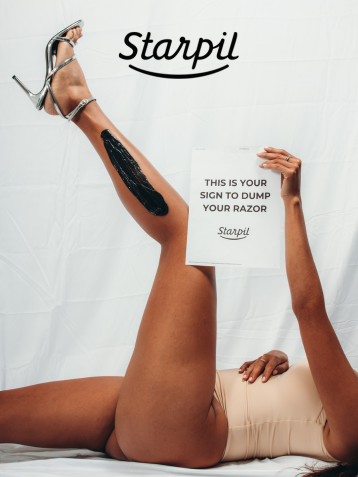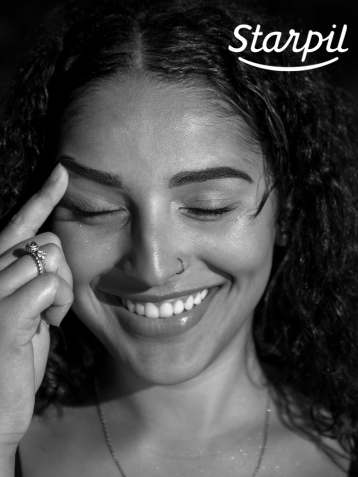Eyebrow Waxing Vs. Threading | Complete Guide for Beginners

If you’re tired of constantly battling unwanted hair growth or ineffective hair removal methods and looking for a more effective solution, you've likely come across two popular options: threading and waxing. Both techniques offer longer-lasting results than shaving, but which one is right for you?
Table of Contents
If you’re not sure which to check out, don’t worry! We’ll go through the pros and cons of each method, which areas they might be best for, and more. Let's dive into the world of threading and waxing to help you make an informed decision.
READ: Waxing vs. Shaving: What is the Best Method for Hair Removal?
Understanding the Basics: Threading vs Waxing
Before we compare these two methods, let's quickly define each:
- Threading: A hair removal technique using a twisted cotton thread to pluck hair from the root. This method is most commonly used for eyebrow hair removal.
- Waxing: A method that applies warm wax to the skin, which adheres to the hair and is then quickly removed, pulling the hair out from the root. This hair removal method is used across the entire body.
READ: Best Hard Wax for Easy Hair Removal

The Pros and Cons of Threading
Pros of Threading:
- Precision: Ideal for small areas like eyebrows
- Quick process: Sessions are typically short
- Less redness: Minimal skin irritation for some people
Cons of Threading:
- Limited areas: Primarily used for facial hair and ineffective for large areas
- Skill-dependent: Results can vary based on the technician's expertise
- Can be painful: Some find it more uncomfortable than waxing
- Frequent sessions: Hair may grow back faster than with waxing
READ: Waxing 101: Which Direction Should You Pull the Wax?
The Pros and Cons of Waxing
Pros of Waxing:
- Versatility: Suitable for most areas of the body
- Longer-lasting results: Hair typically takes 3-6 weeks to regrow
- Exfoliation: Removes dead skin cells along with hair
- Finer regrowth: Hair often grows back softer and thinner over time
- At-home options: Can be done professionally or at home
Cons of Waxing:
- Initial discomfort: Can be painful, especially for beginners
- Waiting period: Hair needs to be a certain length before waxing
- Potential for irritation: Some may experience redness or inflammation post-wax
- Not suitable for everyone: Those with certain skin conditions should avoid waxing
READ: Defining Your Brows: Where Should Your Eyebrows Start?
Waxing vs. Threading: Which is More Effective?
When it comes to effectiveness, waxing often has the edge over threading. Here's why:
- Broader coverage: Waxing can remove hair from larger areas quickly and efficiently.
- Longer-lasting results: Waxed hair typically takes longer to grow back compared to threaded hair.
- Weakened hair follicles: Regular waxing can lead to finer, sparser hair growth over time.
- Exfoliation benefits: Waxing removes dead skin cells, leaving your skin smoother and brighter.
While threading can be incredibly precise for small areas like eyebrows, waxing provides a more comprehensive solution for overall hair removal needs, especially for larger areas of the body.

READ: Exfoliation After Waxing: When and How to Do It Right
Choosing the Right Method for You
Consider the following factors when deciding between threading and waxing:
- Areas to be treated: Threading might be the right decision if you're only concerned with facial hair, particularly eyebrows. For full-body hair removal, waxing is the clear winner.
- Pain tolerance: Both methods can cause discomfort, but the right choice for you depends on your pain tolerance and how quickly you get used to possible discomfort associated with these removal methods.
- Skin sensitivity: If you have extremely sensitive skin, you might prefer threading for facial areas. However, gentler wax formulas, like Starpil Wax’s Starsoft Hard Wax, are available for sensitive skin types.
- Time and convenience: Waxing can be done professionally or at home (with proper practice), offering more flexibility. Threading typically requires a skilled technician.
- Long-term goals: If you're looking for a method that might reduce hair growth over time, waxing is your best bet.

Why Waxing Might Be the Better Choice
While both methods have their merits, waxing offers several advantages that make it a preferred choice for many:
- Versatility: From eyebrows to legs to bikini areas, waxing can handle it all.
- Customization: Various types of wax (hard, soft, or roll-on) cater to different needs and preferences.
- Comprehensive results: Waxing removes hair more completely, leading to smoother skin for longer periods.
- At-home options: With practice, you can achieve salon-quality results at home with the right waxing kit.
- Skin benefits: Regular waxing can lead to improved skin texture and reduced hair growth over time.
READ: Your Complete Guide to Roll-On Waxing
Final Thoughts
Ultimately, the choice between threading and waxing comes down to your personal preferences and needs. If you're looking for a versatile, long-lasting hair removal method that provides flexibility and quality results, waxing is likely your best option. It offers full-body coverage, the potential for reduced hair growth over time, and the added benefit of exfoliation while providing smooth, hair-free skin.

However, if you're primarily concerned with shaping your eyebrows or removing small areas of facial hair, threading can be a good alternative. It's especially useful for those with extremely sensitive skin who may react to waxing products.
Whichever method you choose, always ensure you're getting it done by a trained professional or using high-quality products if you're doing it at home. With the right approach, you'll be on your way to smooth, hair-free skin in no time.
Eyebrow Waxing vs. Threading | FAQs
What's the main difference between eyebrow waxing and threading?
Threading uses a twisted cotton thread to pluck hair from the root and is most commonly used for eyebrow hair removal. Waxing applies warm wax to the skin that adheres to the hair and is quickly removed, pulling hair out from the root. While threading is primarily used for facial hair and small areas, waxing is versatile and can be used across the entire body, including eyebrows.
Which method lasts longer, waxing or threading?
Waxing typically provides longer-lasting results than threading. Waxed hair usually takes 3-6 weeks to regrow, while threaded hair may grow back faster, requiring more frequent sessions. Additionally, regular waxing can lead to finer, sparser hair growth over time as it weakens hair follicles, whereas threading doesn't provide this long-term benefit.
Which is more painful, eyebrow waxing or threading?
Pain tolerance varies from person to person, but many find that both methods cause some discomfort. Threading can be more uncomfortable for some people as it plucks individual hairs, while waxing removes multiple hairs at once quickly. However, the pain is subjective and depends on your individual pain tolerance and how quickly you adapt to the discomfort associated with each method.
Is threading or waxing better for sensitive skin?
For extremely sensitive skin, threading might be preferred for facial areas since it doesn't involve any products that could cause reactions. However, gentler wax formulas like Starpil Wax's Starsoft Hard Wax are specifically designed for sensitive skin types. Threading generally causes less redness and minimal skin irritation for some people, while waxing may cause temporary redness or inflammation post-treatment.
Can I do eyebrow waxing or threading at home?
Waxing offers more flexibility for at-home treatment. With proper practice and high-quality waxing kits, you can achieve salon-quality results at home. Various types of wax (hard, soft, or roll-on) cater to different needs and preferences, and finding the right wax kit can allow you to wax your eyebrows precisely without spending too much.
Threading typically requires a skilled technician and is skill-dependent, meaning results can vary significantly based on expertise. While some people learn to thread at home, it's generally more challenging to master than waxing techniques.







Comments